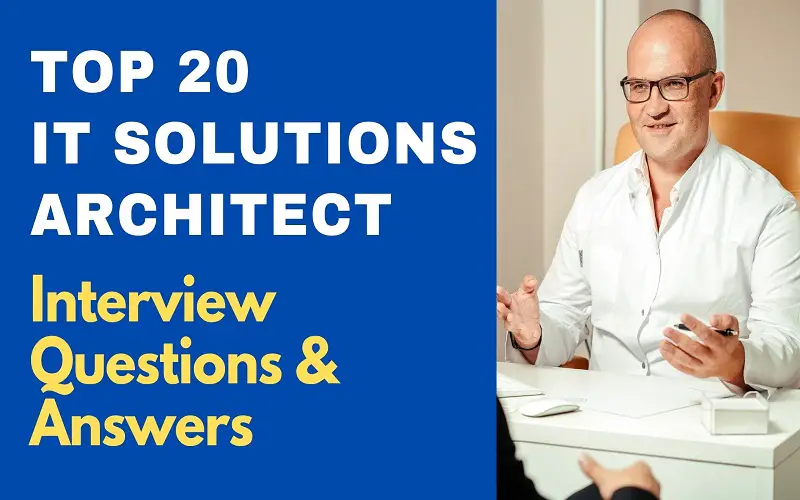We have compiled the top 20 IT Solutions Architect interview questions that might be asked in an interview to test various aspects of skills, with tips and a sample answer for each of them.
1. What Roles Does An IT Solutions Architect Perform?
Solution architecture bridges gaps between technology solutions and business problems. Here, the interviewer will assess if you understand the roles of solution architects.
Tip 1: Describe various roles performed by a solution architect
Tip 2: Be brief but don’t miss out on important points
Sample Answer
“An IT solution architect leads and makes efforts to integrate IT systems so that they can conform to the organization’s requirements. The architect carries out an evaluation of system architecture and collaborates with IT development and project management teams to enhance the architecture.
IT solution architects guide and supervise developers and fix technical issues as they occur. Moreover, they assess project constraints in search of alternatives, undertake process re-engineering when required, and alleviate risks.”
2. During Your Last Role, What Major Challenge Did You Encounter, And How Did You Address It?
Here, the interviewer will try to find out if you can handle challenging situations.
Tip 1: Provide a challenge that will show your ability to deal with difficult situations
Tip 2: Show how you effectively addressed the challenge
Sample Answer
“During my last assignment as a solution architect, I led a solution architects’ team that was involved in designing a mobile banking app. My team got the technology right and delivered the app. However, after implementation, users had a bad experience.
As the team leader, I got lots of pressure from the bank because the app did not meet the expectations. I addressed the situation by engaging my team in researching ways that could improve the app. In the end, some modules were redesigned and the problem got solved.”
3. Which Area Of This Job Do You Find Very Challenging?
Here, the interviewer wants to ascertain whether you are a good fit for the job.
Tip 1: Give a context that solution architects find quite challenging
Tip 2: Provide a practical solution you will use to overcome that challenge
Sample Answer
“With technology advancing rapidly, I anticipate a challenge where some technological solutions under development may become obsolete before they are delivered to the client. To overcome that, I intend to keep abreast of the newest technological advancements and engage with teams to identify the right technological designs to implement for a particular project.”
4. As An IT Solution Architect, Which Highly Innovative Solution Have You Ever Created?
Here, the interviewer will assess your innovativeness and creativity.
Tip 1: Provide an innovative idea or application you came up with
Tip 2: Make sure to explain complex aspects to facilitate understanding
Sample Answer
“Four years ago, I came up with an artificial intelligence calendar app that suggests dates and times based on your meetings. The app can be linked to the email and intelligently suggest meetings’ time.”
5. What Is Meant By Cloud Computing? What Are Its Primary Features And Benefits?
An IT solution architect should keep up-to-date with next-generation technologies. Here, the interviewer wishes to test your understanding of internet-based technologies like cloud computing.
Tip 1: Define cloud computing by describing it
Tip 2: Provide several features and benefits linked to cloud computing
Sample Answer
“Cloud computing is an internet-based computer technology that permits the storage and access of programs and digital information over the internet. It delivers storage, applications, processing power, and other on-demand services via the internet. Users of this technology pay for storage and services provided.
Its main features are scalability and elasticity, self-service billing, automatic de-provisioning, and self-service provisioning.
Some key benefits of this service are cost-effectiveness due to the elimination of capital expenses for purchasing software and hardware. Cloud computing offers powerful server capabilities that enhance access speed. Moreover, it provides secure backups, huge storage space, and incremented productivity.”
6. What Key Qualities Should IT Solution Architects Possess?
Here, the interviewer is interested in knowing if you are well aware of the qualities that an IT solution architect should have.
Tip 1: Give several qualities a good IT solution architect ought to possess
Tip 2: Be brief with your response
Sample Answer
“The role of an IT solution architect requires excellent communication skills and good technical background. Solution architects should have extensive experience across different systems and their architecture. A solution architect ought to have the ability to describe the behavior, characteristics, structure, and other elements of applications.
Moreover, they should be able to analyze technology environments and enterprise specifics. They should also be influential, have good negotiation skills, and be able to work collaboratively.”
7. What Steps Can You Take To Communicate Solutions To Customers Who Can’t Understand Or Agree With Your Assessment?
Here, the interviewer will assess if you can communicate solutions effectively and deal with difficult customers.
Tip 1: Give a brief and precise answer
Tip 2: Provide steps that solution architects can follow to communicate with disagreeing customers
Sample Answer
“To communicate assessment results to clients who can’t understand or agree, I will use the following steps:
- Permit clients to speak out – I will allow the clients to express their views and express their understanding in relation to the assessment until they release their concerns and calm down.
- Demonstrate my care – then I will utilize empathy statements to demonstrate my understanding of the client’s views and frustrations.
- Provide facts – this last step will involve communicating facts clearly to help the customers understand the assessment. When customers understand the triggers and causes, they are likely to understand the assessment results.”
8. Describe The Daily Routine Of An IT Solutions Architect?
Here, the interviewer will assess if you understand what solutions architects do every day.
Tip 1: Describe what the day is like for an IT solutions architect
Tip 2: Provide several activities solutions architects undertake daily
Sample Answer
“The daily activities of IT solutions architects entail correcting technical issues that arise, supervising and guiding development teams, and updating stakeholders about the process, budgets, and costs of project development. An IT solutions architect builds and integrates systems to conform to the organization’s needs.
The architect assesses existing systems architecture and works with technical staff to propose better solutions. Moreover, these experts research emerging technologies and assess the impact of technical risks on the business.”
[VIDEO] Top 20 IT Solutions Architect Interview Questions with Sample Answers: ► Subscribe for more useful videos
9. What Security Approach Do You Take In Your Solutions?
The development of IT solutions ought to be consistent with certain security principles. Here, the interviewer wants to know whether your technological solutions are secure.
Tip 1: Describe the method you apply to guarantee the security
Tip 2: To add weight to your answer, demonstrate that your solutions are secure.
Sample Answer
“I ensure security by guarding databases against SQL injections, encoding data before it is used, and validating input data prior to its storage or use. Moreover, I implement access control to prevent unauthorized access. This also involves protecting the privacy of data through encryption. Moreover, I use HTTPS domains, set strong passwords, and conceal web server information.”
10. How Do IT Solutions Architects Diagnose Performance Issues?
Poor performance translates to losses in terms of decreased productivity, poor customer relations, and lost revenue. Here, the interviewer evaluates whether you are knowledgeable about the diagnosis of performance problems.
Tip 1: Demonstrate that you know how to diagnose performance issues
Tip 2: State ways that are employed in performance diagnosis
Sample Answer
“IT solutions architects can diagnose performance problems in five ways:
- Figuring out the solution that should be achieved.
- Determining the current state of affairs.
- Analyzing whether objectives can be achieved.
- Creating a plan to achieve the objectives.
- Carrying out a project’s economic analysis.”
11. In What Ways Can Scalability Be Addressed?
Here, the interviewer will test your ability to ensure a system can handle an increasing amount of work.
Tip 1: Provide ways in which scalability can be ensured
Tip 2: Be brief and precise with your answer
Sample Answer
“IT solutions architects enhance scalability by investing time in developing great codes. These software codes follow acceptable and standardized design patterns. They also ensure that system architecture, which concerns how codes are deployed on hardware, is designed correctly. If not, a business will have scaling issues. These measures ensure that IT solutions that are designed have the ability to accommodate growth.”
12. How Can You Handle Fault Tolerance?
Fault tolerance consists of the property that makes a system operate continuously when one or more of its components fail. Here, the interview attempts to evaluate your ability to handle system failure.
Tip 1: State the method solutions architects can use in failure tolerance control
Tip 2: Make sure to include all the important points
Sample Answer
“Faults often bring about undesirable reactions and can even lead to a plant shutdown. As an IT solutions architect, I will address failure tolerance using a set of techniques that can increase system availability and minimize safety hazard risks. This set of techniques is collectively referred to as fault tolerance control.
I will use the aspect of failure control including fault diagnosis and assessment. After identifying the fault, I will calculate remedial actions that will correct the identified fault.”
13. Identify The Tools Used By A Solutions Architect. Why Are They Important And How Are They Used?
Here, the interviewer seeks to know whether you are aware of the tools that facilitate the work of an IT solutions architect.
Tip 1: State the tools that solutions architects use in their work
Tip 2: Explain the importance and use of each tool
Sample Answer
“IT solutions architects use the following tools:
- Veracode offers source code analyzing services. Whether you want to analyze software developed by third parties or internally, Veracode will help you accomplish your goal cost-effectively and quickly.
- Nagios – this is an open-source application that is used to monitor networks, systems, and infrastructure. It alerts architects whenever something goes wrong.
- Git – this version control system is applied when solutions architects want to track changes made in source codes during the development of software.
- Travis – this is an integrated tool that is used in building and testing software projects.
- Java – this is an object-oriented coding language that is used to develop applications.
- Terminal – this is a command line that helps architects to execute processes. It helps them to download apps or navigate between files very quickly using a single command.
- Docker – this tool offers an application containerization platform, which allows solutions architects to package software or applications in filesystems. The container can be executed or moved anywhere.”
14. Describe The Metrics Applied To Validate Solution Compliance With The Architecture Of An Enterprise?
This is one of the solution architect interview questions that most probably be asked by many interviewers. Here, the interviewer tests your understanding of the metrics that qualify a solution to enterprise architecture.
Tip 1: State the metrics used in solution validation
Tip 2: Give weight to your answer by briefly explaining your points
Sample Answer
“Testing is one of the key aspects used to validate a software solution and ascertain its compliance with enterprise architecture. It will reveal the compatibility of the application with the existing architecture.
Architecture documentation is the other factor that architects use to determine solution compliance. Using documentation, it is possible to determine the conditions and requirements that solutions should meet in order to comply with architecture.”
15. How Can You Improve Existing Software?
Here, the interviewer will assess if you have the ability to improve a system
Tip 1: Provide ways through which IT solutions architects can improve a system
Tip 2: Make your answer brief and precise
Sample Answer
“Performing an upgrade is one of the effective ways to improve an existing system. Technology keeps changing and for software to remain useful, it should be upgraded to the latest version. Another way to enhance a system is by updating it.
Updating the software gives users access to up-to-date security which the software developers have come up with to be able to protect their applications from malicious viruses. An existing system can also be enhanced by upgrading the hardware.”
16. What New Standard Did You Introduce During Your Last Role? How Did You Ensure It Was Adopted?
Here, the interviewer will assess whether you conform to and popularize set industry standards.
Tip 1: Provide a kind of a standard used in solution architecture
Tip 2: Make sure your answer is brief and clear
Sample Answer
“Yes. This was the use of standard documentation procedures. I ensured its adoption by discussing it with all development team members during a departmental meeting. I also shared templates of the documentation formats so that everyone would have a reference.”
17. What Is Meant By Architectural Risk And How Can It Be Mitigated?
Here, the interviewer will test your understanding of architecture risk.
Tip 1: Clearly describe architecture risk
Tip 2: Provide the method that solution architects can use to mitigate it
Sample Answer
“Architecture risk is the possibility of the failure of architectural design to satisfy projects’ requirements. This includes inefficiencies and flaws rejected by sponsors, substandard quality designs, and capacity limitations.
Architecture risk can be mitigated by following accepted and standard design practices and procedures in software development. Moreover, capturing requirements correctly from clients will prevent design flaws.”
Related Articles:
18. How Is Compliance Architecture Handled?
Here, the interviewer wishes to ascertain whether you are aware of how compliance with architecture is ensured.
Tip 1: Describe how compliance architecture is addressed
Tip 2: Ensure not to miss all important points
Sample Answer
“Ensuring the compliance of applications or projects to the architecture of an enterprise is a critical element of architecture governance. To realize compliance, assessments of a project’s impact are prepared by the architects. Moreover, a review process with regard to architecture compliance is defined by IT.
The review involves scrutinizing the compliance of a particular application project versus the set architectural criteria. These efforts are aimed at identifying errors early on and hence minimize the risk and cost of changes that would be needed later.”
19. What Is A Web Application; Describe Its Components.
The work of IT solutions architects involves the use of web applications. Here, the interviewer tests your understanding of web applications.
Tip 1: Provide a definition of a web application
Tip 2: Describe its components
Sample Answer
“A web application refers to a computer program that uses web technology and browser to perform tasks on the internet. Any web application, whether small or big, has the following components:
- View layer – this layer offers an interface to the application. It acts as a bridge for receiving information in and out of the application.
- Business layer – the business layer is also known as the application layer, domain logic or business logic. Its work is to receive user requests from the internet, process them, and decide the routes through which the information will be accessed. The workflows that enable information and requests to travel via the back end are encoded in an application layer.
- Data access layer – this layer keeps the code that clients use to pull information from their data stores such as flat files, databases, or different web services from the business layer and presentation code.
- Error security, handling, and logging – this is where handling of errors is performed to make users feel well-considered and informed.”
20. What Is TOGAF Framework?
Here, the interviewer will test whether you are familiar with TOGAF.
Tip 1: Start by giving the meaning of TOGAF
Tip 2: Describe TOGAF including its importance
Sample Answer
“TOGAF is the acronym for open group architecture framework. This is a methodology of enterprise architecture that provides a high-end framework for application development. It enables solution architects to organize the software development process systematically with the aim of staying on budget, maintaining timeframes, and reducing errors.
Businesses use TOGAF to align their IT goals with business goals and at the same time enable the organization of IT efforts across all departments. Moreover, it facilitates the organization and definition of requirements before the start of a project to prevent errors and enable project work to be done quickly.”
Conclusion
These are but a few solution architecture interview questions that you need to prepare yourself before attending an interview. Hopefully, these interview questions for solution architects will help you land your next dream job.




